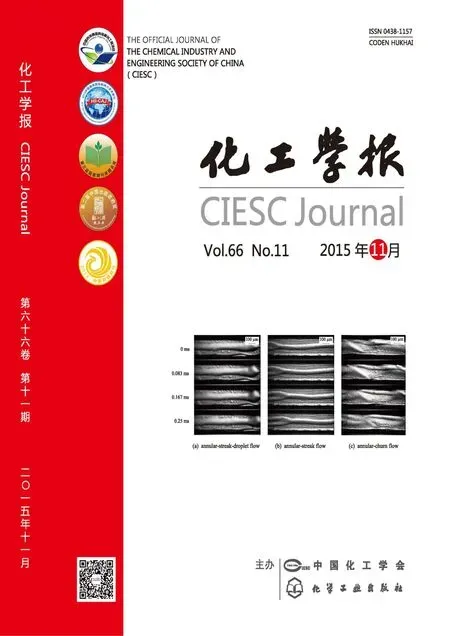MA/EG與TBPA/EG聚酯化反應動力學
孔明華,伍聯營,徐顯朕,胡仰棟
(中國海洋大學化學化工學院,山東 青島 266100)
MA/EG與TBPA/EG聚酯化反應動力學
孔明華,伍聯營,徐顯朕,胡仰棟
(中國海洋大學化學化工學院,山東 青島 266100)
通過熔融縮聚反應對馬來酸酐/乙二醇(MA/EG)和四溴鄰苯二甲酸酐/乙二醇(TBPA/EG)兩個聚酯化反應的動力學進行研究。考察了自催化條件下反應溫度、原料配比對聚酯化反應速率的影響。在陳壽安模型的基礎上,對反應級數的不同組合進行了比較研究。結果表明:1-1模型和實驗結果吻合良好,且kh[H2O]為正值;溫度越高,醇酸配比越大,則聚合反應程度越大。
動力學模型;聚合;酯化;四溴鄰苯二甲酸酐;馬來酸酐
引 言
馬來酸酐和乙二醇是合成不飽和聚酯樹脂的重要原料,四溴鄰苯二甲酸酐是合成阻燃樹脂的主要原料之一。研究MA/EG和TBPA/EG兩個聚酯化反應動力學旨在為阻燃樹脂的工業生產提供必要的動力學數據支持。長期以來,聚酯反應動力學一直受到國內外學者的關注。不同學者對反應級數做了不同假設,并且提出了相應的動力學模型。較早的具有代表性的聚酯化反應動力學模型由 Flory[1-3]提出。Flory認為,自催化聚酯反應總反應級數為 3級,關于羧基濃度為2級,關于羥基濃度為1級,但未考慮副產物水的排除對反應的影響;Lin等[4-5]研究了乙二醇和不同二元酸反應的動力學,提出新的動力學模型,他們認為自催化聚酯反應總反應級數為3級,關于羧基濃度為1級,關于羥基濃度為2級;Fradet等[6]認為水的排出會對反應物單體的濃度產生影響,推導了消除水影響后的聚酯反應動力學方程;Chen等[7-8]研究了自催化和酸催化條件下己二酸和乙二醇反應的動力學,在Tang等[9]和Fang 等[10]的模型的基礎上充分考慮了水的排除,提出新的聚酯反應動力學模型;Kuo等[11]研究了己二酸和不同的二元醇反應的動力學,將陳壽安模型和Flory、Lin的模型進行對比,證明陳壽安模型能更好地描述實驗結果; Zetterlund等[12]進一步探討了丙二醇中兩個羥基不同的反應活性對反應動力學的影響,同時考慮了水和醇的排出,提出了修正的陳壽安模型;Nalampang等[13]研究了不同酸酐和2-甲基-1,3-丙二醇聚酯化反應動力學,證明陳壽安模型能夠描述酸酐和醇反應的實驗結果。喬遷等[14]研究了AA/HPHP和AA/NPG聚酯化反應動力學,認為自催化聚酯反應動力學是一個變級數反應,與反應溫度有關。
本文對自催化條件下MA/EG和TBPA/EG兩個聚酯化反應動力學進行研究,對反應級數的不同組合進行了探討。
1 實 驗
1.1實驗試劑及裝置
馬來酸酐、乙二醇、丙酮、無水乙醇及氫氧化鉀、領苯二甲酸氫鉀:均為分析純,國藥集團化學試劑有限公司;四溴鄰苯二甲酸酐:工業純;酚酞指示劑,參照國標自配。
聚酯化反應器為配有電動攪拌器、溫度計、進氣管和冷凝裝置的500 ml四口圓底燒瓶。采用恒溫油浴加熱,控溫誤差為±0.5℃。
1.2實驗方法
反應物分別預熱,達到反應溫度后混合。固定氮氣流速為50 ml·min-1,攪拌速率為300 r·min-1,反應在常壓和氮氣保護下恒溫進行。每隔一段時間取樣,冷卻稱重,用丙酮溶解,用0.1 mol·L-1的氫氧化鉀乙醇溶液滴定。乙二醇和馬來酸酐采用的醇酸配比為1.2:1,在4個溫度下反應,分別是164、172、182、191℃;在182℃時,研究醇酸配比對反應的影響。醇酸配比分別為1.2、1.5、1.8;四溴苯酐和乙二醇采用的醇酸配比為1:6,在4個溫度下反應,分別是162、172、182、192℃。
2 新的聚酯反應動力學模型
本文研究的是自催化條件下 MA/EG和 TBPA/EG兩個聚酯化反應。以馬來酸酐和乙二醇反應為例,反應式為

戚以政等[15]、梁政勇等[16]認為,第1步反應是快速反應,在升到反應溫度幾分鐘內即可完成。第2步反應是慢速反應,是整個反應的速控步驟,研究第2步反應的反應速率才具有更加實際的意義。陳壽安在唐敖慶模型基礎上,充分考慮了水解反應,提出自催化條件下聚酯反應動力學。

式中,反應程度y=([COOH]0-[COOH])/ [COOH]0,醇酸配比γ=[OH]0/[COOH]0,式(1)轉化為式(2)

式中,k是聚酯反應速率常數;Keo是電離平衡常數;kh是水解反應速率常數;α是與介電常數有關的參數。Chen等[7-8]、Zetterlund等[12]、Nalampang 等[13]認為自催化聚酯反應中, α =0.61; kKeo遵循Arrhenius定律;kh[H2O]是kh和水濃度[H2O]的乘積,在反應中雖有所變化,但近似為常數。
在陳壽安模型的基礎上,對反應級數的不同組合進行了比較研究,如式(3)所示。1-1模型中聚酯化反應關于羧基濃度為1級,關于羥基濃度為1級。1-2模型關于羧基濃度為1級,關于羥基濃度為2級。2-1模型中聚酯化反應關于羧基濃度為 2級,關于羥基濃度為1級,即陳壽安模型。2-2模型中聚酯化反應關于羧基濃度為2級,關于羥基濃度為2級。

3 結果與討論
將實驗與模型關聯結果示于圖 1~圖 4和表1~表5中。圖1是MA/EG在不同溫度下的反應程度-時間曲線;圖2是MA/EG在不同醇酸配比下的反應程度-時間曲線;圖3是TBPA/EG在不同溫度的反應程度-時間曲線;圖4是MA/EG物系反應速率常數 kKeo隨溫度的變化曲線;表 1、表 2是MA/EG和 TBPA/EG兩個物系在 4種模型下的kh[H2O];表3、表4是1-1模型下MA/EG和TBPA/EG兩個物系自催化聚酯反應動力學參數;表5是馬來酸酐和不同二元醇反應的活化能比較。
3.1模型比較
從圖1~圖3可知,MA/EG在不同溫度、醇酸配比下和 TBPA/EG在不同溫度下的實驗結果與1-1、2-1、1-2模型都吻合良好,2-2模型稍差。從表1、表2可知,由 1-1模型擬合得到的kh[H2O]都為正,具有物理意義。而1-2、2-1、2-2模型擬合得到的kh[H2O]存在負值的情況,不具有物理意義。2-1模型中關于羧基濃度為2級,相比于1-1模型中關于羧基濃度為1級,2-1模型中反應速率更快,水的生成速率快,生成的水無法及時脫除,導致kh[H2O]為負;1-2模型和2-2模型同理。

圖1 MA/EG在不同溫度下的反應程度-時間曲線Fig.1 Conversion of COOH vs time at different reaction temperatures of MA/EG system under different models

表1 MA/EG物系在4種模型下的kh[H2O]Table 1 kh[H2O] in MA/EG system under different models

表2 TBPA/EG物系在4種模型下的kh[H2O]Table 2 kh[H2O] in TBPA/EG system under different models

圖2 MA/EG在不同醇酸配比下的反應程度-時間曲線Fig.2 Conversion of COOH vs time at different molar ratios of diol to diacid of MA/EG system under different models
3.21-1模型中動力學參數的確定
從圖1~圖3可知,實驗點和1-1模型曲線吻合良好。溫度越高,醇酸配比越大,則最終轉化率就越高。采用First Optimization進行擬合,得到兩個參數kKeo、kh[H2O]。從表3、表4可知,kKeo隨著溫度的升高而增大,且與醇酸配比大小無關。從圖4可知,kKeo隨溫度的變化符合Arrhenius定律。

表3 1-1模型下MA/EG反應動力學參數Table 3 Kinetics parameters from 1-1 model prediction for MA/EG system

表4 1-1模型下TBPA/EG反應動力學參數Table 4 Kinetics parameters from 1-1 model prediction for TBPA/EG system

表5 馬來酸酐和不同二元醇反應的活化能比較Table 5 Comparison of activation energies between maleic anhydride with different diols

圖3 TBPA/EG在不同溫度下的反應程度-時間曲線Fig.3 Conversion of COOH vs time at different reaction temperatures of TBPA/EG system under different models

圖4 MA/EG物系反應速率常數kKeo隨溫度的變化Fig.4 Arrhenius plots of polyesterification rate constant kKeofor MA/EG system
4 結 論
(1)對自催化條件下的MA/EG和TBPA/EG物系,1-1模型能夠較好地描述實驗結果。由1-1模型擬合得到的動力學參數中kh[H2O]始終為正,具有物理意義。而其他3種模型擬合得到的kh[H2O]存在負值的情況,不具有物理意義。
(2)在實驗所研究的溫度和醇酸配比范圍內,溫度越高,醇酸配比越大,則聚合反應程度越大。MA/EG在T=191℃、r=1.2、反應時間為390 min時,反應程度為91.72%;TBPA/EG在T=192℃、r=6、反應時間為600 min時,反應程度為82.36%。
符號說明
Keo——轉化率為零的平衡電離常數,kg·mol-1
k——聚酯反應速率常數,kg·mol-1·min-1
kh——水解反應速率常數,kg·mol-1·min-1
r——醇酸配比
y——羧基轉化率,%
α ——與介電常數有關的參數
下角標
e——平衡狀態
h——水解反應
o——轉化率為零
References
[1] Flory P J. Kinetics of condensation polymerization: the reaction of ethylene glycol with succinic acid [J]. Am. Chem. Soc., 1937, 59: 466-469.
[2] Flory P J. Kinetics of polyesterification: a study of the effects of molecular weight and viscosity on reaction rate [J]. Am. Chem. Soc., 1939, 61: 3334-3340.
[3] Flory P J. Principles of Polymer Chemistry[M]. New York: Cornell University Press, 1953: 672.
[4] Lin C C, Hsieh K H. The kinetics of polyesterification(Ⅰ): Adipic acid and ethylene glycol [J]. Journal of Applied Polymer Science, 1977, 21: 2711-2719.
[5] Lin C C, Yu P C. The kinetics of polyesterification(Ⅱ): Succinic acid and ethylene glycol [J]. Journal of Polymer Science, 1978, 16: 1005-1016.
[6] Fradet A, Marechal E. Kinetics and mechanisms of polyesterifications(Ⅰ): Diols with diacids [J]. Adv. Polym. Sci., 1982, 43: 51-142.
[7] Chen S A, Hsiao J C. Kinetics of polyesterification(Ⅰ): Dibasic acid and glycol systems [J]. Polym. Sci., 1981, 19: 3123-3136.
[8] Chen S A, Wu K C. Kinetics of polyesterification(Ⅱ): Foreign acid-catalyzed dibasic acid and glycol systems [J]. Polym. Sci., 1982 , 20: 1819-1831.
[9] Tang A C, Yao K S. Mechanism of hydrogen ion catalysis in esterification(Ⅱ): Studies on the kinetics of polyesterification reactions between dibasic acids and glycols [J]. Polym. Sci., 1959, 35: 219-233.
[10] Fang Y R, Lai C G, Lu J L, Chen M K. Kinetics and mechanism of polyesterification of binary acids and binary alcohols [J]. Sci. Sin., 1975, 18: 72-87.
[11] Kuo C T, Chen S A. Kinetics of polyesterification: adipic acid with ethylene glycol, 1,4-butanediol, and 1,6-hexanediol [J]. Polym. Sci., 1989, 27: 2793-803.
[12] Zetterlund P B, Weaver W, Johnson A F. Kinetics of polyesterification: modelling of the condensation of maleic anhydride, phthalic anhydride, and 1,2-propylene glycol [J]. Polym. React. Engng. , 2002, 10(1/ 2): 41-57.
[13] Nalampang K, Johnson A F. Kinetics of polyesterification: modelling and simulation of unsaturated polyester synthesis involving 2-methyl-1,3-propanediol [J]. Polymer, 2003, 44: 6103-6109.
[14] Qiao Qian(喬遷), Zhang Weilu(張偉祿), Zhang Dong(張東), Liu Chunyan(劉春艷), Tian Yiguang(田一光), Zhao Yajuan(趙亞娟). Reaction kinetics in polyesterification of AA/HPHP and AA/NPG [J].Chemical Journal of Chinese Universities(高等學校化學學報), 2004, 25(8): 1545-1548.
[15] Qi Yizheng(戚以政), Feng Yuanding(馮元鼎), Yu Yusun(余玉蓀), Ye Haiping(葉海平), Xu Shengjuan(許勝娟). Kinetic study the esterification of phthalic anhydride with 2-ethylhexanol(Ⅰ ) [J].Journal of Beijing University of Chemical Technology: Natural Science (北京化工學院學報), 1986, 46(2): 10-19.
[16] Liang Zhengyong(梁政勇), Ye Ming(葉明), Zhang Yadong(章亞東). Kinetics study on esterification of phthalic anhydride and allyl alcohol [J]. Chemical Engineering(China)(化學工程), 2011, 39(7): 47-50.
[17] Salmi T, Paatero E, Nyholm P, Still M, Norhi K. Kinetics of melt polymerization of maleic and phthalic acids with propylene glycol [J]. Chem. Engng. Sci., 1994, 49(24B): 5053-5070.
[18] Lehtonen J, Salmi T, Immonen K, Paatero E, Nyholm P. Kinetic model for the homogeneously catalyzed polyesterification of dicarboxylic acids with diols [J]. Ind. Eng. Chem. Res., 1996, 35: 3951-3963.
[19] Lehtonen J, Immonen K, Salmi T, Paatero E, Nyholm P. Kinetic analysis of the reaction network in the catalyzed polyesterification of unsaturated carboxylic acids [J]. Chem. Eng. Sci., 1996, 51: 2799-2804.
[20] Paatero E, Narhi K, Salmi T, Still M, Nyholm P, Immonen K. Kinetics model for main and side reactions in the polyesterification of dicarboxylic acids with diols [J]. Chem. Engng. Sci., 1994, 49(21): 3601-3616.
Kinetics of polyesterification: ethylene glycol with maleic anhydride and tetrabromo phthalic anhydride
KONG Minghua, WU Lianying, XU Xianzhen, HU Yangdong
(School of Chemistry and Chemical Engineering, Ocean University of China, Qingdao 266100, Shandong, China)
Polyesterifications of ethylene glycol (EG) with maleic anhydride (MA) and tetrabromo phthalic anhydride (TBPA) without foreign acid were carried out under constant reaction temperatures of 162—192℃(rather than at the constant oil-bath temperature) and at different molar ratios of diol to diacid of 1.2—1.8 (MA/EG). The different combinations of the reaction order on the basis of Show-an Chen model were discussed. 1-1 model can describe experimental results very well, and kh[H2O] was greater than zero. The reaction rate constants for both systems were calculated. Besides, It was found that the final COOH conversion was increased with increasing reaction temperatures and molar ratios of diol to diacid.
kinetics modeling;polymerization;esterification;tetrabromo phthalic anhydride;maleic anhydride
date: 2015-05-06.
Prof. HU Yangdong, ydhuhd@ouc.edu.cn
supported by the National Natural Science Foundation of China (21376231).
10.11949/j.issn.0438-1157.20150570
TQ 013.2; TQ 323.42
A
0438—1157(2015)11—4446—06
2015-05-06收到初稿,2015-06-15收到修改稿。
聯系人:胡仰棟。第一作者:孔明華(1990—),女,碩士研究生。
國家自然科學基金項目(21376231)。

